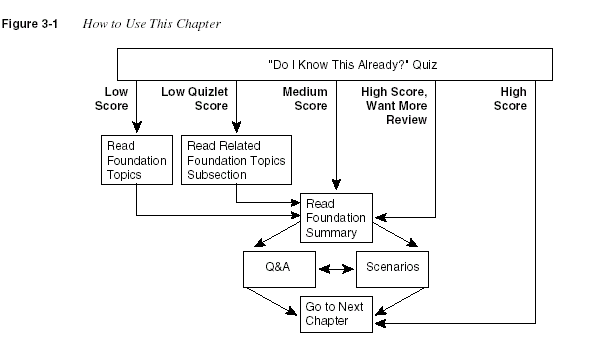
This chapter covers the following topics that you will need to master as a CCNA:
•
The OSI, TCP/IP, and NetWare Protocol Architectures
This section describes
the history of OSI and its relevance to networking in the new millennium. In addition,
this section covers the meaning and usefulness of each layer, the interactions of the
layers, and the encapsulation of data.
•
OSI Transport Layer Functions
Routers and switches are mainly concerned with
protocols similar to the OSI network and data link layers, and sometimes with the
transport layer. This section covers the pertinent details of the transport layer,
including connectionless and connection-oriented operation, error recovery, flow
control, buffering, and windowing.
•
OSI Data Link Layer Functions
Routers, switches, and bridges use data link layer
concepts, both on LAN and WAN connections. This section discusses the data link
functions of arbitration, addressing, error detection, and encapsulation.
•
OSI Network Layer Functions
The network layer defines the core concepts used
by routers. This section discusses network layer addressing and routing in depth.
C
H
A
P
T
E
R
3
OSI Reference Model
& Layered Communication
In years past, the need to understand the Open Systems Interconnection (OSI) reference
model for networking grew rapidly. The U.S. government passed laws requiring vendors to
support OSI software on their systems, or the government would no longer buy the systems.
Several vendors even predicted that the global Internet would evolve toward using the OSI
protocols instead of TCP/IP. As the century turns, however, OSI has been implemented
on a much smaller scale than predicted. Few vendors push their OSI software solutions,
if they even have them. However, several components of the OSI model are popularly
implemented today. For example, OSI network service access point (NSAP) network layer
addresses are often used for signaling in Asynchronous Transfer Mode (ATM) networks.
However, full seven-layer OSI implementations are relatively rare today.
So, why have a whole chapter on OSI? As a CCNA, you’ll be expected to learn and interpret
new technologies and protocols. The OSI seven-layer reference model is an excellent point
of reference for describing the concepts and functions behind these new technologies.
References to Layer 2 switching and Layer 3 switching, which are popular topics today,
refer to the comparison between Layers 2 and 3 of the OSI model. Cisco courses make
generous use of the OSI model as reference for comparison with other network protocol
implementations. So, this chapter will not actually help you understand OSI fully, but rather
it will discuss OSI functions in comparison with popularly implemented protocols.
How to Best Use This Chapter
By taking the following steps, you can make better use of your study time:
•
Keep your notes and the answers for all your work with this book in one place, for
easy reference.
•
Take the “Do I Know This Already?” quiz, and write down your answers. Studies
show that retention is significantly increased through writing down facts and
concepts, even if you never look at the information again.
•
Use the diagram in Figure 3-1 to guide you to the next step.
70
Chapter 3: OSI Reference Model & Layered Communication

“Do I Know This Already?” Quiz
The purpose of the “Do I Know This Already?” quiz is to help you decide what parts of this
chapter to use. If you already intend to read the entire chapter, you do not necessarily need to
answer these questions now.
This 12-question quiz helps you determine how to spend your limited study time. The quiz is
sectioned into four smaller four-question “quizlets,” which correspond to the four major
headings in the “Foundation Topics” section of the chapter. Figure 3-1 outlines suggestions on
how to spend your time in this chapter. Use Table 3-1 to record your score.
Table 3-1
Scoresheet for Quiz and Quizlets
Quizlet
Number
Foundation Topics Section Covering
These Questions Questions Score
1 The OSI, TCP/IP, and NetWare Protocol
Architectures
1 to 4
2 OSI Transport Layer Functions 5 to 8
3 OSI Data Link Layer Functions 9 to 12
4 OSI Network Layer Functions 13 to 16
All questions 1 to 16
“Do I Know This Already?” Quiz
71
1
Name the seven layers of the OSI model.
___________________________________________________________________
___________________________________________________________________
___________________________________________________________________
2
What is the main purpose(s) of Layer 3?
___________________________________________________________________
___________________________________________________________________
___________________________________________________________________
3
What is the main purpose(s) of Layer 2?
___________________________________________________________________
___________________________________________________________________
___________________________________________________________________
4
What OSI layer typically encapsulates using both a header and a trailer?
___________________________________________________________________
___________________________________________________________________
___________________________________________________________________
5
Describe the features required for a protocol to be considered connectionless.
___________________________________________________________________
___________________________________________________________________
___________________________________________________________________
6
Describe the features required for a protocol to be considered connection-oriented.
___________________________________________________________________
___________________________________________________________________
___________________________________________________________________
72
Chapter 3: OSI Reference Model & Layered Communication
7
In a particular error-recovering (reliable) protocol, the sender sends three frames,
labeled 2, 3, and 4. On its next sent frame, the receiver of these frames sets an
acknowledgment field to 4. What does this typically imply?
__________________________________________________________________
__________________________________________________________________
__________________________________________________________________
8
Name three connection-oriented protocols.
__________________________________________________________________
__________________________________________________________________
__________________________________________________________________
9
Name three terms popularly used as synonyms for MAC address.
__________________________________________________________________
__________________________________________________________________
__________________________________________________________________
10
What portion of a MAC address encodes an identifier representing the manufacturer
of the card?
__________________________________________________________________
__________________________________________________________________
__________________________________________________________________
11
Are DLCI addresses defined by a Layer 2 or a Layer 3 protocol?
__________________________________________________________________
__________________________________________________________________
__________________________________________________________________
12
How many bits are present in a MAC address?
__________________________________________________________________
__________________________________________________________________
__________________________________________________________________
“Do I Know This Already?” Quiz
73
13
How many bits are present in an IPX address?
___________________________________________________________________
___________________________________________________________________
___________________________________________________________________
14
Name the two main parts of an IP address. Which part identifies the “group” of which
this address is a member?
___________________________________________________________________
___________________________________________________________________
___________________________________________________________________
15
Describe the differences between a routed protocol and a routing protocol.
___________________________________________________________________
___________________________________________________________________
___________________________________________________________________
16
Name at least three routed protocols.
___________________________________________________________________
___________________________________________________________________
___________________________________________________________________
The answers to the “Do I Know This Already?” quiz are found in Appendix A, “Answers to the
‘Do I Know This Already?’ Quizzes and Q&A Sections,” on page 708. The suggested choices
for your next step are as follows:
•
8 or less overall score
—Read the entire chapter. This includes the “Foundation Topics”
and “Foundation Summary” sections, the Q&A section, and the scenarios at the end of the
chapter.
•
2 or less on any quizlet
—Review the subsection(s) of the “Foundation Topics” part of
this chapter, based on Table 3-1. Then, move into the “Foundation Summary” section, the
quiz, and the scenarios at the end of the chapter.
•
9 to 12 overall score
—Begin with the “Foundation Summary” section, and then go to the
Q&A section and the scenarios at the end of the chapter.
•
13 or more overall score
—If you want more review on these topics, skip to the
“Foundation Summary” section and then go to the Q&A section and the scenarios at the
end of the chapter. Otherwise, move to the next chapter.
74
Chapter 3: OSI Reference Model & Layered Communication
Foundation Topics
The OSI, TCP/IP, and NetWare Protocol Architectures
Four topics of particular importance for the CCNA exam are covered in this chapter:
•
The OSI model
—Expect questions on the functions of each layer and examples at each
layer in the CCNA exam.
•
Data link protocols
—This section is important to properly understand LAN switching.
•
Network layer protocols
—This section is important to properly understand routing.
•
Transport layer protocols
—This section is important to properly understand end-to-end
transport.
The last three sections all use the terminology discussed in the first section.
OSI: Origin and Evolution
To pass the CCNA exam, you must be conversant in a protocol specification with which you are
very unlikely to have any hands-on experience. The difficulty these days when using the OSI
protocol specifications as a point of reference is that almost no one uses those specifications.
You cannot typically walk down the hall and see a computer whose main, or even optional,
networking protocols are defined by OSI.
OSI is the Open Systems Interconnection reference model for communications. OSI is a rather
well-defined set of protocol specifications with many options for accomplishing similar tasks.
Some participants in OSI’s creation and development wanted it to become
the
networking
protocol used by all applications. The U.S. government went so far as to require OSI support
on every computer it would buy (as of a certain date in the early 1990s) via an edict called the
Government OSI Profile (GOSIP), which certainly gave vendors some incentive to write OSI
code. In fact, in my old IBM days, the company even had charts showing how the TCP/IP
installed base would start declining by 1994, how OSI installations would take off, and how OSI
would be
the
protocol from which the twenty-first century Internet was built. (In IBM’s defense,
moving the world to OSI may have been yet another case of “You just can’t get there from
here.”)
What is OSI today? Well, the protocols are still in existence and are used around the world, to
some degree. The U.S. government reversed its GOSIP directive officially in May 1994, which
was probably the final blow to the possibility of pervasive OSI implementations. Cisco routers
will route OSI. OSI NSAP addresses are used in Cisco ATM devices for signaling. Digital
Equipment’s DECnet Phase V uses several portions of OSI, including the network layer (Layer
3) addressing and routing concepts. More often than not, however, the OSI model now is mainly
used as a point of reference for discussing other protocol specifications.
The OSI, TCP/IP, and NetWare Protocol Architectures
75
OSI Layers
The OSI model consists of seven layers, each of which can (and typically does) have several
sublayers. Cisco requires that CCNAs demonstrate an understanding of each layer as well as
the protocols that correspond to each OSI layer. The names of the OSI model layers and their
main functions are simply good things to memorize. And frankly, if you want to pursue your
Cisco certifications beyond CCNA, these names and functional areas will come up continually.
The upper layers of the OSI model (application, presentation, and session—Layers 7, 6, and 5)
are oriented more toward services to the applications. The lower four layers (transport, network,
data link, and physical—Layers 4, 3, 2, and 1) are oriented more toward the flows of data from
end to end through the network. CCNAs work mostly with issues in the lower layers, in
particular with Layer 2, upon which switching is based, and Layer 3, upon which routing is
based. Table 3-2 diagrams the seven OSI layers, with a thorough description and a list of
example protocols.
Table 3-2
OSI Reference Model
Layer Name Functional Description Examples
Application
(Layer 7)
An application that communicates with other computers
is implementing OSI application layer concepts. The
application layer refers to communications services to
applications. For example, a word processor that lacks
communications capabilities would not implement code
for communications, and word processor programmers
would not be concerned about OSI Layer 7. However, if
an option for transferring a file were added, then the word
processor would need to implement OSI Layer 7 (or the
equivalent layer in another protocol specification).
Telnet, HTTP, FTP,
WWW browsers, NFS,
SMTP gateways
(Eudora, CC:mail),
SNMP, X.400 mail,
FTAM
Presentation
(Layer 6)
This layer’s main purpose is defining data formats, such
as ASCII text, EBCDIC text, binary, BCD, and JPEG.
Encryption is also defined by OSI as a presentation layer
service. For example, FTP enables you to choose binary
or ASCII transfer. If binary is selected, the sender and
receiver do not modify the contents of the file. If ASCII is
chosen, the sender translates the text from the sender’s
character set to a standard ASCII and sends the data. The
receiver translates back from the standard ASCII to the
character set used on the receiving computer.
JPEG, ASCII, EBCDIC,
TIFF, GIF, PICT,
encryption, MPEG,
MIDI
continues
76
Chapter 3: OSI Reference Model & Layered Communication
Session
(Layer 5)
The session layer defines how to start, control, and end
conversations (called sessions). This includes the control
and management of multiple bidirectional messages so
that the application can be notified if only some of a
series of messages are completed. This allows the
presentation layer to have a seamless view of an
incoming stream of data. The presentation layer can be
presented with data if all flows occur in some cases. For
example, an automated teller machine transaction in
which you withdraw cash from your checking account
should not debit your account, and then fail, before
handing you the cash, recording the transaction even
though you did not receive money. The session layer
creates ways to imply which flows are part of the same
session and which flows must complete before any are
considered complete.
RPC, SQL, NFS,
NetBios names,
AppleTalk ASP, DECnet
SCP
Transport
(Layer 4)
Layer 4 includes the choice of protocols that either do or
do not provide error recovery. Multiplexing of incoming
data for different flows to applications on the same
host (for example, TCP sockets) is also performed.
Reordering of the incoming data stream when packets
arrive out of order is included.
TCP, UDP, SPX
Network
(Layer 3)
This layer defines end-to-end delivery of packets. To
accomplish this, the network layer defines logical
addressing so that any endpoint can be identified. It also
defines how routing works and how routes are learned so
that the packets can be delivered. The network layer also
defines how to fragment a packet into smaller packets to
accommodate media with smaller maximum transmission
unit sizes. (Note: Not all Layer 3 protocols use
fragmentation.) The network layer of OSI defines most of
the details that a Cisco router considers when routing. For
example, IP running in a Cisco router is responsible for
examining the destination IP address of a packet,
comparing that address to the IP routing table,
fragmenting the packet if the outgoing interface requires
smaller packets, and queuing the packet to be sent out to
the interface.
IP, IPX, AppleTalk DDP
Table 3-2
OSI Reference Model (Continued)
Layer Name Functional Description Examples
The OSI, TCP/IP, and NetWare Protocol Architectures
77
Some protocols define details of multiple layers. For example, because the TCP/IP application
layer correlates to OSI Layers 5 through 7, the Network File System (NFS) implements
elements matching all three layers. Likewise, the 802.3, 802.5, and Ethernet standards define
details for the data link and physical layers.
CCNAs deal with many aspects of Layers 1 through 4 on a daily basis. However, the upper
layers are not as important to CCNAs. In addition, most networking people know what the OSI
model is but do not need to memorize everything about it. Table 3-2 shows plenty of detail and
explanation for a more in-depth idea of the OSI model components. If you are daunted by the
task of memorizing all the examples in Table 3-2, you can refer to Table 3-3, which offers a
Data link
(Layer 2)
The data link (Layer 2) specifications are concerned with
getting data across one particular link or medium. The
data link protocols define delivery across an individual
link. These protocols are necessarily concerned with the
type of media in question; for example, 802.3 and 802.2
are specifications from the IEEE, which are referenced
by OSI as valid data link (Layer 2) protocols. These
specifications define how Ethernet works. Other
protocols, such as High-Level Data Link Control
(HDLC) for a point-to-point WAN link, deal with the
different details of a WAN link. As with other protocol
specifications, OSI often does not create any original
specification for the data link layer but instead relies on
other standards bodies such as IEEE to create new
standards for the data link layer and the physical layer.
IEEE 802.3/802.2,
HDLC, Frame Relay,
PPP, FDDI, ATM, IEEE
802.5/ 802.2
Physical
(Layer 1)
These physical layer (Layer 1) specifications, which are
also typically standards from other organizations that are
referred to by OSI, deal with the physical characteristics
of the transmission medium. Connectors, pins, use of
pins, electrical currents, encoding, and light modulation
are all part of different physical layer specifications.
Multiple specifications are sometimes used to complete
all details of the physical layer. For example, RJ-45
defines the shape of the connector and the number of
wires or pins in the cable. Ethernet and 802.3 define the
use of wires or pins 1, 2, 3, and 6. So, to use a category 5
cable, with an RJ-45 connector for an Ethernet
connection, Ethernet and RJ-45 physical layer
specifications are used.
EIA/TIA-232, V.35,
EIA/TIA- 449, V.24,
RJ45, Ethernet, 802.3,
802.5, FDDI, NRZI,
NRZ, B8ZS
Table 3-2
OSI Reference Model (Continued)
Layer Name Functional Description Examples
78
Chapter 3: OSI Reference Model & Layered Communication
more condensed description of the layer characteristics and examples. This table is taken
directly from Cisco’s ICND course, so if you are just not willing to try and remember all of
Table 3-2, the information in Table 3-3 is a good compromise. (ICND is the instructor-led
course in the official CCNA training path.)
Layering Benefits and Concepts
Many benefits can be gained from the process of breaking up the functions or tasks of
networking into smaller chunks, called layers, and defining standard interfaces between these
layers. One obvious benefit is that the individual protocols or layers are less complex and
therefore can be defined in great detail. The following list summarizes the benefits of layered
protocol specifications:
•
Humans can discuss and learn about the many details of a protocol specification easier.
•
Standardized interfaces among layers facilitates modular engineering. Different products
can provide functions of only some layers (such as a router with Layers 1 to 3), or some
products could supply parts of the functions of the protocol (such as Microsoft TCP/IP
built into Win95, or the Eudora e-mail application providing TCP/IP application layer
support).
Table 3-3
OSI Reference Model (Condensed Information)
OSI Layer Name Functional Description Examples
Application (Layer 7) User interface Telnet, HTTP
Presentation (Layer 6) How data is presented
Special processing, such as encryption
JPEG, ASCII, EBCDIC
Session (Layer 5) Keeping data separate from different
applications
Operating systems and
application access
scheduling
Transport (Layer 4) Reliable or unreliable delivery
Multiplexing
TCP, UDP, SPX
Network (Layer 3) Logical addressing, which routers use for path
determination
IP, IPX
Data link (Layer 2) Combination of bits into bytes, and bytes into
frames
Access to the media using MAC address
Error detection and error recovery
802.3/802.2, HDLC
Physical (Layer 1) Moving of bits between devices
Specification of voltage, wire speed, and cable
pin-outs
EIA/TIA-232, V.35
The OSI, TCP/IP, and NetWare Protocol Architectures
79
•
A better environment for interoperability is created.
•
Reduced complexity allows easier program changes and faster product evolution.
•
Each layer can define headers and trailers around the user data. Anyone examining these
headers or trailers for troubleshooting can find the header or trailer for Layer
X
and know
what type of information should be found.
•
One layer uses the services of the layer immediately below it. Therefore, remembering
what each layer does is easier. (For example, the network layer needs to deliver data from
end to end. To do this, it uses data links to forward data to the next successive device along
that end-to-end path.)
Interaction Between OSI Layers
CCNAs frequently deal with the concepts of layer interaction and encapsulation, particularly
because routers build new data link headers and trailers to encapsulate the packets they route.
The process of how layers interact on the same computer, as well as how the same layer
processes on different computers communicate with each other, is all interrelated. The software
or hardware products implementing the logic of some of the OSI protocol layers provide two
general functions:
•
Each layer provides a service to the layer above it in the protocol specification.
•
Each layer communicates some information with the same layer’s software or hardware
on other computers. In some cases, the other computer is connected to the same media; in
other cases, the other computer is on the other end of the network.
In the coming pages, you will learn more about each of these two functions.
Interactions Between Adjacent Layers on the Same Computer
To provide services to the next higher layer, a layer must know about the standard interfaces
defined between layers. These interfaces include definitions of what Layer
N
+1 must provide
to Layer
N
to get services, as well as what information Layer
N
must provide back to Layer
N
+1.
Figure 3-2 presents a graphical representation of two computers and provides an excellent
backdrop for a discussion of interactions between layers on the same computer.
80
Chapter 3: OSI Reference Model & Layered Communication
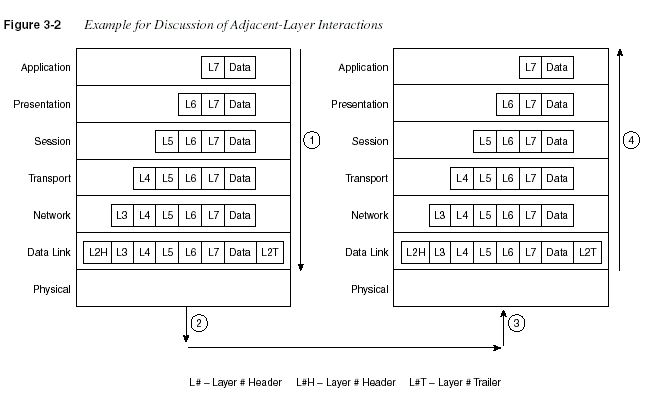
the user. Each layer creates a header and passes the data down to the next layer. (The arrows in
Figure 3-2, Step 1, denote the passing of data between layers.) Passing the data down to the next
layer implies that the lower layer needs to perform some services for the higher layer; to
perform these services, the lower layer adds some information in a header or trailer. For
example, the transport layer hands off its data and header; the network layer adds a header with
the correct destination network layer address so that the packet can be delivered to the other
computer.
From each layer’s perspective, the bits after that layer’s header are considered to be data. For
instance, Layer 4 considers the Layer 5, 6, and 7 headers, along with the original user data, to
be one large data field.
After the application creates the data, the software and hardware implementing each layer
perform their work, adding the appropriate header and trailer. The physical layer can use the
media to send a signal for physical transmission, as shown in Step 2 in Figure 3-2.
Upon receipt (Step 3), Host B begins the adjacent layer interactions on Host B. The right side
of Figure 3-2 shows an arrow pointing next to the computer (Step 4), signifying that the
received data is being processed as it goes up the protocol stack. In fact, thinking about what
each layer does in the OSI model can help you decide what information could be in each header.
The OSI, TCP/IP, and NetWare Protocol Architectures
81The following sequence outlines the basics of processing at each layer and shows how each
lower layer provides a service to the next higher layer. Consider the receipt of data by the host
on the right side of Figure 3-2:
Step 1
The physical layer (Layer 1) ensures bit synchronization andplaces the received binary pattern into a buffer. It notifies the data
link layer that a frame has been received after decoding the
incoming signal into a bit stream. Therefore, Layer 1 has provided
delivery of a stream of bits across the medium.
Step 2
The data link layer examines the frame check sequence (FCS) inthe trailer to determine whether errors occurred in transmission
(error detection). If an error has occurred, the frame is discarded.
(Some data link protocols perform error
recovery, and some donot.) The data link address(es) are examined so that Host B can
decide whether to process the data further. If the data is addressed
to host B, the data between the Layer 2 header and trailer is given
to the Layer 3 software. The data link has delivered the data across
that link.
Step 3
The network layer (Layer 3) destination address is examined. Ifthe address is Host B’s address, processing continues (logical
addressing) and the data after the Layer 3 header is given to the
transport layer (Layer 4) software. Layer 3 has provided the
service of end-to-end delivery.
Step 4
If error recovery was an option chosen for the transport layer(Layer 4), the counters identifying this piece of data are encoded
in the Layer 4 header along with acknowledgment information
(error recovery). After error recovery and reordering of the
incoming data, the data is given to the session layer.
Step 5
The session layer (Layer 5) can be used to ensure that a seriesof messages is completed. For example, this data could be
meaningless if the next four exchanges are not completed. The
Layer 5 header could include fields signifying that this is a middle
flow in a chain, not an ending flow. After the session layer ensures
that all flows are completed, it passes the data after the Layer 5
header to the Layer 6 software.
Step 6
The presentation layer (Layer 6) defines and manipulates dataformats. For example, if the data is binary instead of character
data, the header denotes that fact. The receiver does not attempt to
convert the data using the default ASCII character set of Host B.
Typically, this type of header is included only for initialization
flows, not with every message being transmitted (data formats).
82
Chapter 3: OSI Reference Model & Layered CommunicationAfter the data formats have been converted, the data (after the
Layer 6 header) is then passed to the application layer (Layer 7)
software.
Step 7
The application layer (Layer 7) processes the final header and thencan examine the true end-user data. This header signifies
agreement to operating parameters by the applications on Host A
and Host B. The headers are used to signal the values for all
parameters; therefore, the header typically is sent and received at
application initialization time only. For example, for file transfer,
the size of the file to be transferred and the file formats used would
be communicated (application parameters).
Interactions Between the Same Layers on Different Computers
Layer
N must interact with Layer N on another computer to successfully implement itsfunctions. For example, the transport layer (Layer 4) can send data, but if another computer
does not acknowledge that the data was received, the sender will not know when to perform
error recovery. Likewise, the sending computer encodes a destination network layer address
(Layer 3) in the network layer header. If the intervening routers do not cooperate by performing
their network layer tasks, the packet will not be delivered to the true destination.
To interact with the same layer on another computer, each layer defines a header and, in some
cases, a trailer. Headers and trailers are additional data bits, created by the sending computer’s
software or hardware, that are placed before or after the data given to Layer
N by Layer N+1.The information needed for this layer to communicate with the same layer process on the other
computer is encoded in the header and trailer. The receiving computer’s Layer
N software orhardware interprets the headers and trailers created by the sending computer’s Layer
N, learninghow Layer
N’s processing is being handled, in this case.Figure 3-3 provides a conceptual perspective on the same-layer interactions. The application
layer on Host A communicates with the application layer on Host B. Likewise, the transport,
session, and presentation layers on Host A and Host B also communicate. The bottom three
layers of the OSI model have to do with delivery of the data; Router 1 is involved in that process.
Host A’s network, physical, and data link layers communicate with Router 1; likewise, Router
1 communicates with Host B’s physical, data link, and network layers. Figure 3-3 provides a
visual representation of the same-layer interaction concepts.
The OSI, TCP/IP, and NetWare Protocol Architectures
83
The concept of placing data behind headers (and before trailers) for each layer is typically
called
encapsulation by Cisco documentation. As seen previously in Figure 3-2, when eachlayer creates its header, it places the data given to it by the next-higher layer behind its own
header, thereby encapsulating the higher layer’s data. In the case of a data link (Layer 2)
protocol, the Layer 3 header and data are placed between the Layer 2 header and the Layer 2
trailer. The physical layer does not use encapsulation because it does not use headers or trailers.
Again referring to Figure 3-2, Step 1, the following list describes the encapsulation process
from user creation of the data until the physical signal is encoded at Step 2:
Step 1
The application has already created the data. The application layercreates the application header and places the data behind it. This
data structure is passed to the presentation layer.
Step 2
The presentation layer creates the presentation header and placesthe data behind it. This data structure is passed to the session layer.
Step 3
The session layer creates the session header and places the databehind it. This data structure is passed to the transport layer.
Step 4
The transport layer creates the transport header and places the databehind it. This data structure is passed to the network layer.
Step 5
The network layer creates the network header and places the databehind it. This data structure is passed to the data link layer.
84
Chapter 3: OSI Reference Model & Layered CommunicationStep 6
The data link layer creates the data link header and places the databehind it. The data link trailer is added to the end of the structure.
This data structure is passed to the physical layer.
Step 7
The physical layer encodes a signal onto the medium to transmitthe frame.
The previous seven-step process is accurate and meaningful for the seven-layer OSI model.
However, encapsulation by each layer does not happen (typically) for each transmission of data
by the application. Normally, Layers 5 through 7 use headers during initialization (and on
occasion after initialization), but in most flows, there is no Layer 5, 6, or 7 header. This is
because there is no new information to exchange for every flow of data.
An analogy can help in this case. A friend of mine from church spent several summers teaching
English in a communist country. When I wrote to her, she assumed that I would write in English,
but I could not write about “church” without the sensors tossing the letter. So, we agreed on
encryption before she left. Under our code, God was called “Phil,” and I could write things such
as, “I saw Fred at Phil’s house yesterday, and he said hi.” I still had to address the letters before
I mailed them, just like the lower OSI layers need to exchange some information for every piece
of data sent. I didn’t need to repeat what “Phil” really meant in each letter, just like the upper
layers do not need to repeat encryption rules.
Previous CCNA exams referred to a five-step process for encapsulation. This included the
typical encapsulation by the transport, network, and data link layers as steps 2 through 4 in the
process. The first step was the application’s creation of the data, and the last step was the
physical layer’s transmission of the bit stream. In case any questions remain in the CCNA
question database referring to a five-step encapsulation process, the following list provides the
details and explanation.
NOTE
The term LxPDU, where x represents the number of one of the layers, is used to represent thebits that include the headers and trailers for that layer, as well as the encapsulated data. For
instance, an IP packet is an L3PDU, which includes the IP header and any encapsulated data.
Step 1
Create the data—This simply means that the application has datato send.
Step 2
Package the data for transport—In other words, the transportlayer creates the transport header and places the data behind it.
The L4PDU is created here.
The OSI, TCP/IP, and NetWare Protocol Architectures
85Step 3
Add the destination network layer address to the data—Thenetwork layer creates the network header, which includes the
network layer address, and places the data (L4PDU) behind it. In
other words, the L3PDU is created here.
Step 4
Add the destination data link address to the data—The datalink layer creates the data link header, places the data (L3PDU)
behind it, and places the data link trailer at the end. In other words,
the L2PDU is created here.
Step 5
Transmit the bits—The physical layer encodes a signal onto themedium to transmit the frame.
This five-step process happens to match the TCP/IP network model very well. Figure 3-4
depicts the concept; the numbers shown represent each of the five steps.
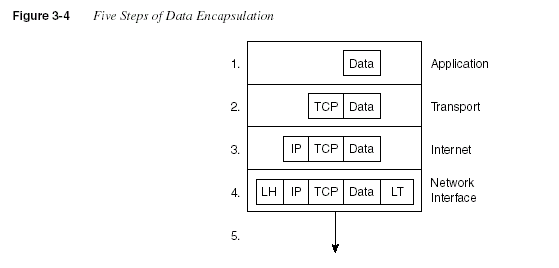
needed to discuss the data that a particular layer is processing.
Layer N PDU (protocol dataunit) is a term used to describe a set of bytes that includes the Layer
N header and trailer, allheaders encapsulated, and the user data. From Layer
N’s perspective, the higher-layer headersand the user data form one large
data or information field. A few other terms also describe someof these PDUs. The Layer 2 PDU (including the data link header and trailer) is called a
frame.Similarly, the Layer 3 PDU is called a
packet, or sometimes a datagram. Finally, the Layer 4PDU is called a
segment. Figure 3-5 illustrates the construction of frames, packets, andsegments and the different layers’ perspectives on what is considered to be
data.86
Chapter 3: OSI Reference Model & Layered Communication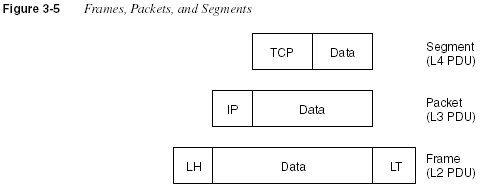
The TCP/IP and NetWare Protocols
Two of the most pervasively deployed protocols are TCP/IP and Novell NetWare; these also are
the two key protocol architectures covered on the CCNA exam. TCP/IP and NetWare are
covered in much more detail in the upcoming chapters.
This short section compares TCP/IP, Novell, and OSI. The goal is to provide some insight into
what some popularly used terminology really means. In particular, routing is defined as a
Layer3 process
; this section reviews how that term relates to TCP/IP and NetWare.For perspective, Figure 3-6 shows the layers of these two protocols as compared with OSI.
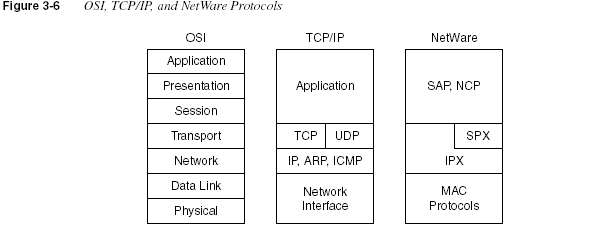
As Figure 3-6 illustrates, the IP and IPX protocols most closely match the OSI network layer—
Layer 3. Many times, even on the CCNA exam, IP and IPX will be called
Layer 3 protocols.Clearly, IP is in TCP/IP’s Layer 2, but for consistent use of terminology, it is commonly called
a Layer 3 protocol because its functions most closely match OSI’s Layer 3. Both IP and IPX
define logical addressing, routing, the learning of routing information, and end-to-end delivery
rules.
OSI Transport Layer Functions
87As with OSI Layers 1 and 2 (physical and data link, respectively), the lower layers of each stack
simply refer to other well-known specifications. For example, the lower layers all support the
IEEE standards for Ethernet and Token Ring, the ANSI standard for FDDI, the ITU standard
for ISDN, and the Frame Relay protocols specified by the Frame Relay Forum, ANSI, and the
ITU. The protocol stacks can accommodate other evolving Layer 1 and Layer 2 specifications
more easily by referring to emerging international standards rather than trying to evolve these
standards themselves.
OSI Transport Layer Functions
The transport layer (Layer 4) defines several functions. Two important features covered in this
chapter are error recovery and flow control. Routers discard packets for many reasons,
including bit errors, congestion that has caused a lack of buffer space, and instances in which
no correct routes are known. The transport layer can provide for retransmission (error recovery)
and can help avoid congestion (flow control).
Transport layer protocols are typically categorized as either connectionless or connectionoriented,
so CCNAs deal with the concepts of connectionless and connection-oriented
protocols on a regular basis. This next section compares the two and provides some explanation
for the functions of each. Error recovery and flow control are covered in the section “How Error
Recovery Is Accomplished.”
Connection-Oriented Versus Connectionless Protocols
The terms
connection-oriented and connectionless have some relatively well-knownconnotations inside the world of networking protocols. However, the typical connotation can be
a bit misleading. For instance, most people correlate connection-oriented protocols with
reliable or error-recovering protocols because the two features are often implemented by a
single protocol. However, connection-oriented protocols do not have to provide error recovery,
and error-recovering protocols do not have to be connection-oriented.
First, some basic definitions are in order:
Connection-oriented protocol: A protocol that either requires an exchange of messages
before data transfer begins or has a required pre-established correlation between two
endpoints.
Connectionless protocol: A protocol that does not require an exchange of messages and
that does not require a pre-established correlation between two endpoints.
The definitions are sufficiently general so that all cases can be covered. TCP is connectionoriented
because a set of three messages must be completed before data is exchanged. Likewise,
SPX is connection-oriented. Frame Relay, when using PVCs, does not require any messages be
sent ahead of time, but it does require predefinition in the Frame Relay switches, establishing a
88
Chapter 3: OSI Reference Model & Layered Communicationconnection between two Frame Relay attached devices. ATM PVCs are also connectionoriented,
for similar reasons.
As mentioned earlier, connection-oriented protocols are often assumed to also perform error
recovery. However, Frame Relay and ATM are two examples in which the protocols are
connection-oriented but the protocol does not provide error recovery. Table 3-4 provides some
example protocols and tells whether they are connection-oriented and error-recovering.
The most typical option is for a protocol to be connectionless and not perform error recovery,
or to be connection-oriented and to also perform error recovery. In fact, many connectionoriented
protocols exchange information important to error recovery when the connection is
established.
Cisco expects CCNAs to be able to distinguish between
error detection and error recovery. Anyheader or trailer with a frame check sequence (FCS) or similar field can be used to detect bit
errors in the PDU. Error detection uses the FCS to detect the error, which results in discarding
the PDU. However, error recovery implies that the protocol reacts to the lost data and somehow
causes the data to be retransmitted. An example of error recovery is shown later in this section.
NOTE
Some documentation refers to the terms connected or connection-oriented. These terms areused synonymously. You will most likely see the use of the term
connection-oriented in Ciscodocumentation.
In the context of previous Cisco official courses, reliable, error-recovering protocols were
always defined as also being connection-oriented. In the current ICND course, part of the
official Cisco CCNA training path, those references have been removed. If you are studying
using an older ICRC or CRLS course book, pay particular attention to the comparisons made
about connection orientation and error recovery in this book.
Table 3-4
Protocol Characteristics: Recovery and ConnectionsConnected? Reliable? Examples
Connection-oriented Yes LLC type 2 (802.2), TCP (TCP/IP), SPX
(NetWare), X.25
Connection-oriented No Frame Relay virtual circuits, ATM virtual
connections, PPP
Connectionless Yes TFTP, NetWare NCP (without Packet Burst)
Connectionless No UDP, IP, IPX, AppleTalk DDP, most Layer 3
protocols, 802.3, 802.5
OSI Transport Layer Functions
89The following litany describes the attitude of the current Cisco course books on error recovery:
•
The protocol implementing the connection defines headers and uses part of these headersto number and acknowledge the data. For example, TCP provides error recovery and
defines a TCP header. The headers used by that protocol have some numbering and
acknowledgment fields to both acknowledge data and notice when it has been lost in
transmission. The endpoints that are sending and receiving data use the fields in this
header to identify that data was sent and to signify that data was received.
•
A sender of data will want an acknowledgment of the data. When an error occurs, manyerror-recovery algorithms require the sender to send all data, starting with the lost data. To
limit the negative effect of having to resend lots of data, a window of unacknowledged
data, which can be dynamic in size, is defined. This window defines the maximum amount
of data that can be sent without getting an acknowledgment.
How Error Recovery Is Accomplished
Regardless of which protocol specification performs the error recovery, all work in basically the
same way. Generically, the transmitted data is labeled or numbered. After receipt, the receiver
signals back to the sender that the data was received, using the same label or number to identify
the data. Figure 3-7 summarizes the operation.
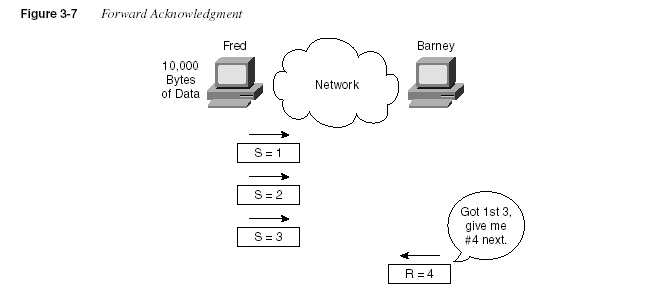
As Figure 3-7 illustrates, the data is numbered, as shown with the numbers 1, 2, and 3. These
numbers are placed into the header used by that particular protocol; for example, the TCP
header contains similar numbering fields. When Barney sends his next frame to Fred, Barney
acknowledges that all three frames were received by setting his acknowledgment field to 4. The
number 4 refers to the next data to be received, which is called
forward acknowledgment. This90
Chapter 3: OSI Reference Model & Layered Communicationmeans that the acknowledgment number in the header identifies the next data that is to be
received, not the last one received. (In this case, 4 is next to be received.)
In some protocols, such as LLC2, the numbering always starts with zero. In other protocols,
such as TCP, the number is stated during initialization by the sending machine. Also, some
protocols count the frame/packet/segment as 1; others count the number of bytes sent. In any
case, the basic idea is the same.
Of course, error recovery has not been covered yet. Take the case of Fred and Barney again, but
notice Barney’s reply in Figure 3-8.
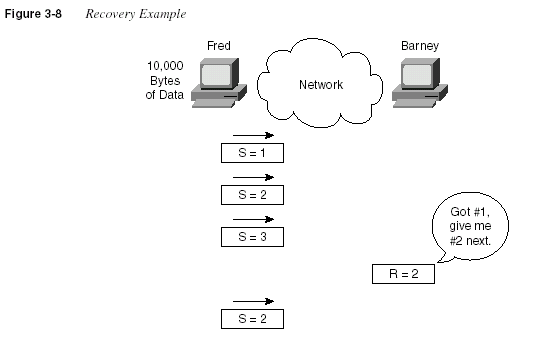
Because Barney is expecting packet number 2 next, what could Fred do? Two choices exist.
Fred could send numbers 2 and 3 again, or Fred could send number 2 and wait, hoping that
Barney’s next acknowledgment will say 4, indicating that Barney just got number 2 and already
had number 3 from earlier.
Finally, error recovery typically uses two sets of counters: one to count data in one direction,
and one to count data in the opposite direction. So, when Barney acknowledges packet number
2 with the
number acknowledged field in the header, the header would also have a number sentfield that identifies the data in Barney’s packet. For instance, assume in Figure 3-8 that the
previous packet Barney had sent was number 5. The packet shown in the figure would be
labeled 6.
Table 3-5 summarizes the concepts behind error recovery and lists the behavior of three popular
error-recovery protocols.
OSI Transport Layer Functions
91Flow Control
Flow control is the process of controlling the rate at which a computer sends data. Depending
on the particular protocol, both the sender and the receiver of the data (as well as any
intermediate routers, bridges, or switches) might participate in the process of controlling the
flow from sender to receiver.
Flow control is needed because data is discarded when congestion occurs. A sender of data
might be sending the data faster than the receiver can receive the data, so the receiver discards
the data. Also, the sender might be sending the data faster than the intermediate switching
devices (switches and routers) can forward the data, also causing discards. Packets can be lost
due to transmission errors as well. This happens in every network, sometimes temporarily and
sometimes regularly, depending on the network and the traffic patterns. The receiving computer
can have insufficient buffer space to receive the next incoming frame, or possibly the CPU is
too busy to process the incoming frame. Intermediate routers might need to discard the packets
based on temporary lack of buffers or processing as well.
Flow control attempts to reduce unnecessary discarding of data. Comparing flows when flow
control is used, and when it is not used, is helpful for understanding why flow control can be
useful. Without flow control, some PDUs are discarded. If some reliable protocol in use
happens to implement error recovery, then the data is re-sent. The sender keeps sending as fast
as possible. With flow control, the sender can be slowed down enough that the original PDU
can be forwarded to the receiving computer, and the receiving computer can process the PDU.
Flow-control protocols do not prevent the loss of data due to congestion; these protocols simply
reduce the amount of lost data, which in turn reduces the amount of retransmitted traffic, which
hopefully reduces overall congestion. However, with flow control, the sender is artificially
slowed or throttled so that it sends data less quickly than it could without flow control.
The CCNA exam requires that you be familiar with three features, or methods, of implementing
flow control:
•
Buffering•
Congestion avoidance•
WindowingTable 3-5
Examples of Error-Recovery Protocols and Their FeaturesFeature TCP SPX LLC2
Acknowledges data in both directions? Yes Yes Yes
Uses forward acknowledgment? Yes Yes Yes
Counts bytes or frame/packets? Bytes Packets Frames
Necessitates resending of all data, or
just one part and wait when resending?
One and wait Resend all Resend all
92
Chapter 3: OSI Reference Model & Layered CommunicationBuffering
Buffering
simply means that the computers reserve enough buffer space that bursts of incomingdata can be held until processed. No attempt is made to actually slow the transmission rate of
the sender of the data. In fact, buffering is such a common method of dealing with changes in
the rate of arrival of data that most of us would probably just assume that it is happening.
However, some older documentation refers to “three methods of flow control,” of which
buffering is one of the methods, so be sure to remember it as a separate function.
Congestion Avoidance
Congestion avoidance
is the second method of flow control covered here. The computerreceiving the data notices that its buffers are filling. This causes either a separate PDU, or field
in a header, to be sent toward the sender, signaling the sender to stop transmitting. Figure 3-9
shows an example.
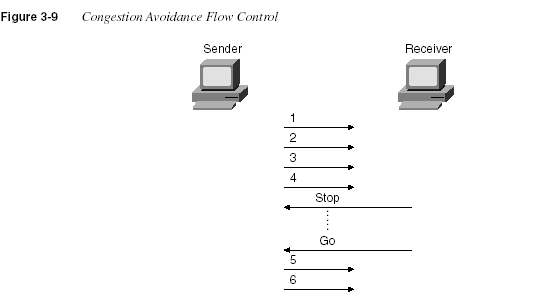
“Hurry up and wait” is a popular expression used to describe the process used in this congestion
avoidance example. This process is used by Synchronous Data Link Control (SDLC) and Link
Access Procedure, Balanced (LAPB) serial data link protocols.
A preferred method might be to get the sender to simply slow down instead of stopping
altogether. This method would still be considered congestion avoidance, but instead of
signaling the sender to stop, the signal would mean to slow down. One example is the TCP/IP
Internet Control Message Protocol (ICMP) message “Source Quench.” This message is sent by
the receiver or some intermediate router to slow the sender. The sender can slow down gradually
until “Source Quench” messages are no longer received.
OSI Transport Layer Functions
93Windowing
The third category of flow-control methods is called
windowing. A window is the maximumamount of data the sender can send without getting an acknowledgment. If no acknowledgment
is received by the time the window is filled, then the sender must wait for acknowledgment.
Figure 3-10 shows an example. The slanted lines indicate the time difference between sending
a PDU and its receipt.
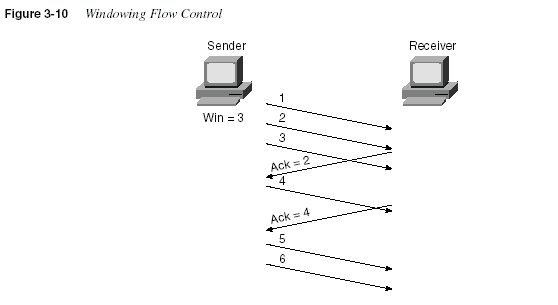
In this example, the sender has a window of three frames. After the receiver acknowledges the
receipt of frame 1, frame 4 can be sent. After a time lapse, the acknowledgment for frames 2
and 3 are received, which is signified by the frame sent by the receiver with the acknowledgment
field equal to 4. So, the sender is free to send two more frames—frames 5 and 6—
before another acknowledgment is received.
Flow Control Summary
One of Cisco’s goals for CCNA and its other certifications is to ensure that passing means that
you really understand the technology rather than simply understanding how to pass a particular
exam. Focusing on understanding the concepts, as always, gives you a chance to get the exam
questions correct. Table 3-6 summarizes the flow control terms and provides examples of each
type. Memorizing these terms should help trigger your memory of flow-control concepts.
94
Chapter 3: OSI Reference Model & Layered CommunicationOSI Data Link Layer Functions
As a CCNA, you’ll need to understand both the abstract concepts about the OSI layers and
particular instances of such protocols. This section focuses on more of the abstract concepts.
Chapter 4, “Bridges/Switches and LAN Design,” and Chapter 8, “WAN Protocols and
Design,” provide more details about particular data link protocols, as well as their configuration
in the IOS.
This section examines four different protocols: Ethernet, Token Ring, HDLC, and Frame Relay.
A generalized definition of the function of a data link protocol will be used to guide you through
the comparison of these four data link protocols. This definition could be used to examine any
other data link protocol. The four components of this definition of the functions of data link
(Layer 2) protocols are as follows:
•
Arbitration—Determines when it is appropriate to use the physical medium.•
Addressing—Ensures that the correct recipient(s) receives and processes the data thatis sent.
•
Error detection—Determines whether the data made the trip across the mediumsuccessfully.
•
Identifying the encapsulated data—Determines the type of header that follows the datalink header. This feature is included in a subset of data link protocols.
Ethernet and Token Ring are two popular LAN Layer 2 protocols. These protocols are defined
by the IEEE in specifications 802.3 and 802.5, respectively. Because 802.3 and 802.5 define
how a station accesses the media, the IEEE calls these protocols Media Access Control (MAC)
protocols. Also, both 802.3 and 802.5 call for the use of another IEEE specification as a separate
part of the data link layer, namely 802.2 Logical Link Control (LLC). 802.2 is purposefully
designed to provide functions common to both Ethernet and Token Ring, whereas 802.3 and
802.5 were designed specifically for data link functions pertinent to either Ethernet or Token
Ring topologies, respectively.
The Ethernet standards before the IEEE created 802.3 have been called
DIX Ethernet for quitea while (the letters DIX represent Digital, Intel, and Xerox). DIX Version 2 defines similar
functions to both the 802.3 and 802.2 specifications.
Table 3-6
Flow-Control Methods—SummaryName Used in This Book Other Names Example Protocols
Buffering N/A N/A
Congestion Avoidance Stop/Start, RNR, Source Quench SDLC, LAPB, LLC2
Windowing N/A TCP, SPX, LLC2
OSI Data Link Layer Functions
95HDLC is the default data link protocol (encapsulation) on Cisco routers serial interfaces. Frame
Relay headers are coincidentally based on the HDLC specification, but Frame Relay was
created for multiaccess networks (with more than two devices). The clear differences between
Frame Relay and HDLC provide a good backdrop to examine the functions of the data link
layer (Layer 2).
Data Link Function 1: Arbitration
Arbitration is needed only when there are instants in time during which it is not appropriate to
send data across the media. LANs were originally defined as a shared media on which each
device must wait until the appropriate time to send data. The specifications for these data link
protocols define how to arbitrate the use of the physical medium.
Ethernet uses the carrier sense multiple access collision detect (CSMA/CD) algorithm for
arbitration. The basic algorithm for using an Ethernet when there is data to be sent consists of
the following steps:
Step 1
Listen to find out whether a frame is currently being received.Step 2
If no other frame is on the Ethernet, send.Step 3
If another frame is on the Ethernet, wait and then listen again.Step 4
While sending, if a collision occurs, stop, wait, and listen again.With Token Ring, a totally different mechanism is used. A free-token frame rotates around the
ring while no device has data to send. When sending, a device claims the free token, which
really means changing bits in the 802.5 header to signify “token busy.” The data is then placed
onto the ring after the Token Ring header. The basic algorithm for using a Token Ring when
there is data to be sent consists of the following steps:
Step 1
Listen for the passing token.Step 2
If token is busy, listen for the next token.Step 3
If the token is free, mark the token as a busy token, append thedata, and send the data onto the ring.
Step 4
When the header with the busy token returns to the sender of thatframe, after completing a full revolution around the ring, the
sender removes the data from the ring.
Step 5
The device sends a free token to allow another station to send aframe.
The algorithm for Token Ring does have other rules and variations, but these are beyond the
depth of what is needed for the CCNA exam. Network Associates (the “Sniffer” people) have
an excellent class covering Token Ring in detail. To find out more about these classes, go to
www.nai.com.
96
Chapter 3: OSI Reference Model & Layered CommunicationWith HDLC, arbitration is a nonissue today. HDLC is used on point-to-point links, which are
typically full-duplex (four-wire) circuits. In other words, either endpoint can send at any time.
From a physical perspective, Frame Relay is comprised of a leased line between a router and
the Frame Relay switch. These links are also typically full-duplex links, so no arbitration is
needed. The Frame Relay network is shared among many data terminal equipment (DTE)
devices, whereas the access link is not shared, so arbitration of the medium is not an issue.
CAUTION
A Word About FramesAs used in this book and in the ICND course, the word
frame refers to particular parts of thedata as sent on a link. In particular,
frame implies that the data link header and trailer are partof the bits being examined and discussed. Figure 3-11 shows frames for the four data link
protocols.

Data Link Function 2: Addressing
Cisco requires that CCNAs master the formats and meanings of data link and network layer
addresses. Addressing is needed on LANs because there can be many possible recipients of
data—that is, there could be more than two devices on the link. Because LANs are
broadcastmedia
—a term signifying that all devices on the media receive the same data—each recipientmust ask the question, “Is this frame meant for me?”
With Ethernet and Token Ring, the addresses are very similar. Each uses Media Access Control
(MAC) addresses, which are 6 bytes long and are represented as a 12-digit hexadecimal
number. Table 3-7 summarizes most of the details about MAC addresses.
Table 3-7
LAN MAC Address Terminology and FeaturesLAN Addressing Terms and
Features Description
MAC Media Access Control. 802.3 (Ethernet) and 802.5 (Token
Ring) are the MAC sublayers of these two LAN data link
protocols.
OSI Data Link Layer Functions
97HDLC includes a meaningless address field because it is used only on point-to-point serial
links. The recipient is implied; if one device sent a frame, the other device is the only possible
intended recipient.
With Frame Relay, there is one physical link that has many logical circuits called
virtual circuits(VCs)
. (See Chapter 8 for more background on Frame Relay.) The address field in Frame Relaydefines a data-link connection identifier (DLCI), which identifies each VC. For example, in
Figure 3-12, the Frame Relay switch to which router Timbuktu is connected receives frames;
the switch forwards the frame to either Kalamazoo or East Egypt based on the DLCI, which
identifies each VC. So, Timbuktu has one physical connection but multiple logical connections.
Ethernet address, NIC address, LAN
address, Token Ring address, card
address
Other names often used instead of MAC address. These
terms describe the 6-byte address of the LAN interface card.
Burned-in address The 6-byte address assigned by the vendor making the card.
It is usually burned in to a ROM or EEPROM on the LAN
card and begins with a 3-byte Organizationally Unique
Identifier (OUI) assigned by the IEEE.
Locally administered address Via configuration, an address that is used instead of the
burned-in address.
Unicast address Fancy term for a MAC that represents a single LAN
interface.
Broadcast address An address that means “all devices that reside on this LAN
right now.”
Multicast address Not valid on Token Ring. On Ethernet, a multicast address
implies some subset of all devices currently on the LAN.
Functional address Not valid on Ethernet. On Token Ring, these addresses are
reserved to represent the device(s) on the ring performing a
particular function. For example, all source-route bridges
supply the ring number to other devices; to do so, they each
listen for the Ring Parameter Server (RPS) functional
address.
Table 3-7
LAN MAC Address Terminology and Features (Continued)LAN Addressing Terms and
Features Description
98
Chapter 3: OSI Reference Model & Layered Communication
Data Link Function 3: Error Detection
Error detection is simply the process of learning whether bit errors occurred during the
transmission of the frame. To do this, most data links include a
frame check sequence (FCS) orcyclical redundancy check (CRC)
field in the data link trailer. This field contains a value that isthe result of a mathematical formula applied to the data in the frame. The FCS value calculated
and sent by the sender should match the value calculated by the receiver. All four data links
discussed in this section contain an FCS field in the frame trailer.
Error detection does not imply recovery; most data links, including 802.5 Token Ring and 802.3
Ethernet, do not provide error recovery. In these two cases, however, an option in the 802.2
protocol, called LLC type 2, does perform error recovery. (SNA and NetBIOS are the typical
higher-layer protocols in use that request the services of LLC2.)
Data Link Function 4: Identifying the Encapsulated Data
Finally, the fourth part of a data link identifies the contents of the data field in the frame. Figure
3-13 helps make the usefulness of this feature apparent.
OSI Data Link Layer Functions
99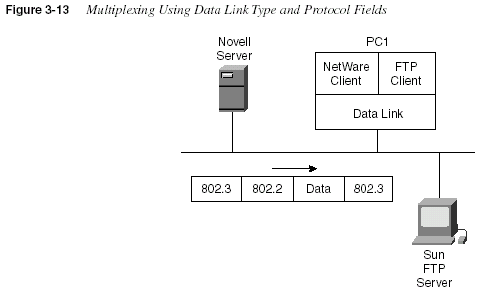
When PC1 receives data, does it give the data to the TCP/IP software or the NetWare client
software? Of course, that depends on what is inside the data field. If the data came from the
Novell server, then PC1 hands the data off to the NetWare client code. If the data comes from
the Sun FTP server, PC1 hands it off to the TCP/IP code.
Ethernet and Token Ring 802.2 LLC provide a field in its header to identify the type of data in
the data field.
PC1 receives frames that basically look like the two shown in Figure 3-14. Each data link
header has a field with a code that means IP, or IPX, or some other designation defining the type
of protocol header that follows. The first item to examine in the header is the 802.2 DSAP field.
In the first frame in Figure 3-14, the destination service access point (DSAP) field has a value
of E0, which means that the next header is a Novell IPX header. In the second frame, the DSAP
field is AA, which implies that a SNAP header follows. Next, the type field in the Subnetwork
Access Protocol (SNAP) header, which has a value of 0800, signifies that the next header is an
IP header. RFC 1700, the “Assigned Numbers” RFC (http://www.isi.edu/in-notes/rfc1700.txt),
lists the SAP and SNAP Type field values and the protocol types they imply.
Similarly, HDLC and Frame Relay need to identify the contents of the data field. Of course, it
is atypical to have end-user devices attached to either of these types of data links. In this case,
routers provide an example more typically found in most WAN environments, as shown in
Figure 3-15.
100
Chapter 3: OSI Reference Model & Layered Communication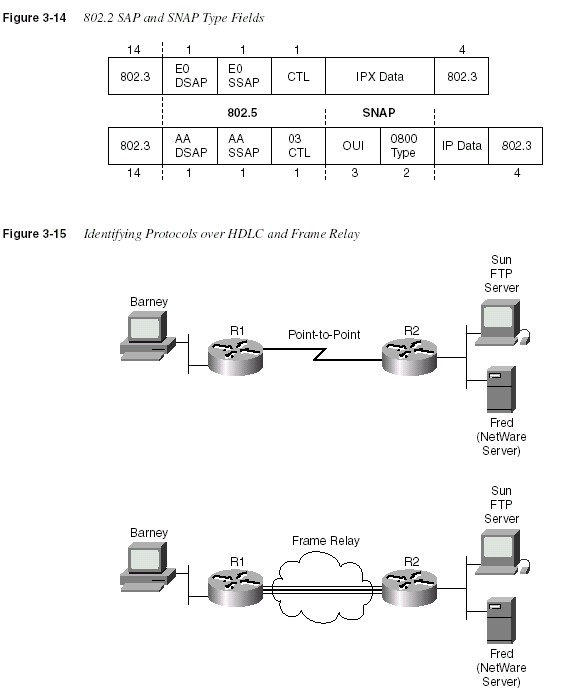
Referring to the top part of Figure 3-15, if Barney is using FTP to transfer files to the Sun system
and is also connected to the NetWare server (Fred) using IPX, then Barney will generate both
TCP/IP and NetWare IPX traffic. As this traffic passes over the HDLC controlled link, R2 will
need to know whether an IP or IPX packet follows the HDLC header. Mainly, this is so that the
OSI Data Link Layer Functions
101router can find the Layer 3 destination address, assume its length (32 bits or 80 bits), perform
table lookup in the correct routing table (ID or IPX), and make the correct routing decision.
HDLC does not provide a mechanism to identify the type of packet in the data field. IOS adds
a proprietary 2-byte field immediately after the HDLC header that identifies the contents of the
data. As shown in the bottom of Figure 3-15, the intervening Frame Relay switches do not care
what is inside the data field. The receiving router, R2, does care for the same reasons that R2
cares when using HDLC—that is, the receiving router needs to know whether an IP or IPX
packet follows the Frame Relay header. Frame Relay headers originally did not address this
issue, either, because the headers were based on HDLC. However, the IETF created a
specification called RFC 1490 that defined additional headers that followed the standard Frame
Relay header. These headers include several fields that can be used to identify the data so that
the receiving device knows what type is hidden inside.
The ITU and ANSI picked up the specifications of RFC 1490 and added it to their official Frame
Relay standards: ITU T1.617 Annex F and ANSI Q.933 Annex E, respectively.
Figure 3-16 shows the fields that identify the type of protocol found in the data field.
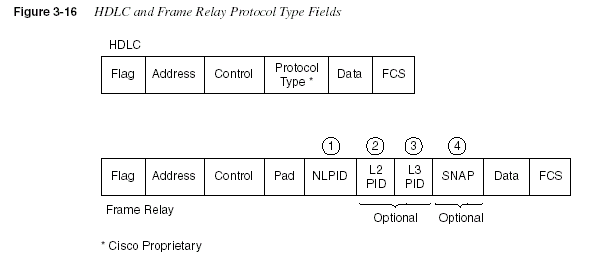
As seen in Figure 3-16, a protocol type field comes after the HDLC control field. In the Frame
Relay example, four different options exist for identifying the type of data inside the frame.
RFC 2427, which obsoletes RFC 1490, provides a complete reference and is useful reading for
those of you moving on to CCNP certification (www.isi.edu/in-notes/rfc2427.txt). (“Obsoletes”
in the RFC world implies that a newer document has superceded it but does not necessarily
mean that all or most of the original RFC has been changed.)
Table 3-8 summarizes the different choices for encoding protocol types for each of the four
data link protocols. Notice that the length of some of these fields is only 1 byte, which
historically has led to the addition of other headers. For example, the SNAP header contains a
2-byte type field because a 1-byte DSAP field is not big enough to number all the available
options for what type of protocol is inside the data.
102
Chapter 3: OSI Reference Model & Layered CommunicationSummary: Data Link Functions
Table 3-9 summarizes the basic functions of data link protocols:
Table 3-8
Different Choices for Encoding Protocol Types for Each of the Four Example Data Link ProtocolsData Link Protocol Field
Header in Which It
Is Found Size
802.3 Ethernet and
802.5 Token Ring
DSAP 802.2 header 1 byte
802.3 Ethernet and
802.5 Token Ring
SSAP 802.2 header 1 byte
802.3 Ethernet and
802.5 Token Ring
Protocol Type SNAP header 2 bytes
Ethernet (DIX) Ethertype Ethernet header 2 bytes
HDLC Cisco proprietary
protocol id field
Extra Cisco header 2 bytes
Frame Relay RFC 2427 NLPID RFC 1490 1 byte
Frame Relay RFC 2427 L2 or L3 Protocol ID Q.933 2 bytes each
Frame Relay RFC 2427 SNAP Protocol Type SNAP Header 2 bytes
Table 3-9
Data link Protocol FunctionsFunction Ethernet Token Ring HDLC Frame Relay
Arbitration CSMA/CD
Algorithm (part of
MAC)
Token passing
(part of MAC)
— —
Addressing Source and
destination MAC
addresses
Source and
destination MAC
addresses
Single 1-byte
address;
unimportant on
point-to-point links
DLCI used to
identify virtual
circuits
Error Detection FCS in trailer FCS in trailer FCS in trailer FCS in trailer
Identifying
contents of
data
802.2 DSAP, SNAP
header, or
Ethertype, as
needed
802.2 DSAP or
SNAP header, as
needed
Proprietary Type
field
RFC 1490/2427
headers, with
NLPID, L2 and
L3 protocol IDs,
or SNAP header
OSI Network Layer Functions
103OSI Network Layer Functions
On the CCNA exam, the two key functions for any Layer 3 protocol are
routing and addressing.These two functions are intertwined and are best understood by considering both at the same
time.
Network layer (Layer 3) addressing will be covered in enough depth to describe IP, IPX, and
AppleTalk addresses. Also, now that data link and network layer addresses have been covered
in this chapter, this section undertakes a comparison of the two as well.
Routing
Routing can be thought of as a three-step process, as seen in Figure 3-17. Thinking about
routing in these three separate steps helps make some of the details more obvious. However,
most people will not think of routing as a three-step process when going about their normal
jobs—this is just a tool to make a few points more clearly.
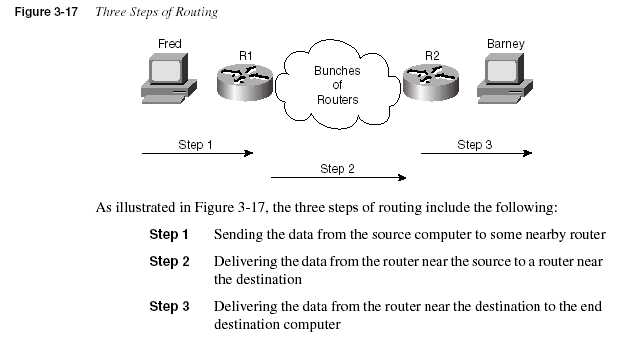
Step 1: Sending Data to a Nearby Router
The creator of the data, who is also the sender of the data, decides to send data to a device in
another group. A mechanism must be in place so that the sender knows of some router on a
common data link with the sender
to ensure that data can be sent to that router. The sender sendsa data link frame across the medium to the nearby router; this frame includes the packet in the
104
Chapter 3: OSI Reference Model & Layered Communicationdata portion of the frame. That frame uses data link (Layer 2) addressing in the data link header
to ensure that the nearby router receives the frame.
Step 2: Routing Data Across the Network
The routing table for that particular network layer protocol type is nothing more than a list of
network layer address groupings. As shown in Table 3-10 later in this section, these groupings
vary based on the network layer protocol type. The router compares the destination network
layer address in the packet to the entries in the routing table in memory, and a match is made.
This matching entry in the routing table tells this router where to forward the packet next.
Any intervening routers repeat the same process. The destination network layer (Layer 3)
address in the packet identifies the group in which the destination resides. The routing table is
searched for a matching entry, which tells this router where to forward the packet next.
Eventually, the packet is delivered to the router connected to the network or subnet of the
destination host, as previously shown in Figure 3-17.
Step 3: Delivering Data to the End Destination
When the packet arrives at a router sharing a data link with the true destination, the router and
the destination of the packet are in the same L3 grouping. That final router can forward the data
directly to the destination. As usual, a new data link header and trailer are created before a frame
(which contains the packet that made the trip across the entire network) can be sent on to the
media. This matches the final step (Step 3), as previously shown in Figure 3-17.
A Comment About Data Links
Because the routers build new data link headers and trailers, and because the new headers
contain data link addresses, the routers must have some way to decide what data link addresses
to use. An example of how the router determines which data link address to use is the IP Address
Resolution Protocol (ARP) protocol. ARP is used to dynamically learn the data link address of
some IP host.
An example specific to TCP/IP will be useful to solidify the concepts behind routing. Imagine
that PC1 is sending packets to PC2. (If you do not understand the basics of IP addressing
already, you may want to bookmark this page and refer to it after you have reviewed Chapter 5,
which covers IP addressing.) Figure 3-18 provides an example network so that you can review
the routing process.
OSI Network Layer Functions
105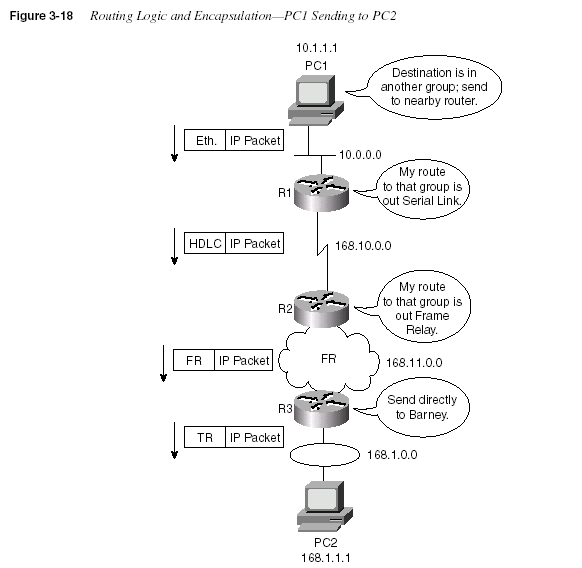
The logic behind the earlier three-step routing process is described in the following steps. Steps
A and B that follow describe the first of the three routing steps in this example. Steps C, D, E,
F, and G correspond to Step 2. Finally, Step H corresponds to routing Step 3.
Step A
PC1 needs to know its nearby router. PC1 first knows of R1’s IPaddress by having either a
default router or a default gatewayconfigured. The default router defined on some host is the router
to which that host forwards packets that are destined for subnets
other than the directly attached subnet. Alternatively, PC1 can
learn of R1’s IP address using Dynamic Host Configuration
106
Chapter 3: OSI Reference Model & Layered CommunicationProtocol (DHCP). Because DHCP is not mentioned for the CCNA
exam, you can assume that a default router of 10.1.1.100 is
configured on PC1 and that it is R1’s Ethernet IP address.
Step B
PC1 needs to know R1’s Ethernet MAC address before PC1 canfinish building the Ethernet header (see Figure 3-18). In the case
of TCP/IP, the ARP process is used to dynamically learn R1’s
MAC address. (See Chapter 5 for a discussion of ARP.) When
R1’s MAC address is known, PC1 completes the Ethernet header
with the destination MAC address being R1’s MAC address.
Step C
At Step 2 of the routing process, the router has many items toconsider. First, the incoming frame (Ethernet interface) is
processed only if the Ethernet FCS is passed and the router’s MAC
address is in the destination address field. Then, the appropriate
protocol type
field is examined so that R1 knows what type ofpacket is in the data portion of the frame. At this point, R1 discards
the Ethernet header and trailer.
Step D
The next part of Step 2 involves finding an entry in the routingtable for network 168.1.0.0, the network of which PC2 is a
member. In this case, the route in R1 references 168.1.0.0 and lists
R1’s serial interface as the interface by which to forward the
packet.
Step E
To complete Step 2, R2 builds an HDLC header and trailer toplace around the IP packet. Because HDLC data link uses the
same address field every time, no process like ARP is needed to
allow R1 to build the HDLC header.
Step F
Routing Step 2 is repeated by R2 when it receives the HDLCframe. The HDLC FCS is checked; the type field is examined to
learn that the packet inside the frame is an IP packet, and then the
HDLC header and trailer are discarded. The IP routing table in R2
is examined for network 168.1.0.0, and a match is made. The entry
directs R2 to forward the packet to its Frame Relay serial
interface. The routing entry also identifies the next router’s IP
address—namely R3’s IP address on the other end of the Frame
Relay VC.
Step G
Before R2 can complete its Step 2 of this end-to-end routingalgorithm, R2 must build a Frame Relay header and trailer. Before
it can complete the task, the correct DLCI for the VC to R3 must
be decided. In most cases today, the dynamic Inverse ARP process
will have associated R3’s IP address with the DLCI R2 uses to
OSI Network Layer Functions
107send frames to R3. (See Chapter 8 for more details on Inverse ARP
and Frame Relay mapping.) With that mapping information, R2
can complete the Frame Relay header and send the frame to R3.
Step H
Step 3 of the original algorithm is performed by R3. Like R1 andR2 before it, R3 checks the FCS in the data link trailer, looks at
the type field to decide whether the packet inside the frame is an
IP packet, and then discards the Frame Relay header and trailer.
The routing table entry for 168.1.0.0 shows that the outgoing
interface is R3’s Token Ring interface. However, there is no next
router IP address because there is no need to forward the packet to
another router. R3 simply needs to build a Token Ring header and
trailer and forward the frame that contains the original packet to
PC2. Before R3 can finish building the Token Ring header, an IP
ARP must be used to find PC2’s MAC address (assuming that R3
doesn’t already have that information in its IP ARP cache).
Network Layer (Layer 3) Addressing
Cisco requires that CCNAs master the details of Layer 3 addressing, both the concepts and the
particulars of IP and IPX. One key feature of network layer addresses is that they were designed
to allow logical grouping of addresses. In other words, something about the numeric value of
an address implies a group or set of addresses, all of which are considered to be in the same
grouping. In TCP/IP, this group is called a
network or a subnet. In IPX, it is called a network.In AppleTalk, the grouping is called a
cable range.Network layer addresses are also grouped based on physical location in a network. The rules
differ for some network layer protocols, but the grouping concept is identical for IP, IPX, and
AppleTalk. In each of these network layer protocols, all devices with addresses in the same
group cannot be separated from each other by a router that is configured to route that protocol,
respectively. Stated differently, all devices in the same group (subnet/network/cable range)
must be connected to the same data link; for example, all devices must be connected to the same
Ethernet.
Routing relies on the fact that Layer 3 addresses are grouped together. The routing tables for
each network layer protocol can reference the group, not each individual address. Imagine an
Ethernet with 100 Novell clients. A router needing to forward packets to any of those clients
needs only one entry in its IPX routing table. If those clients were not required to be attached
to the same data link, and if there was no way to encode the IPX network number in the IPX
address of the client, routing would not be capable of using just one entry in the table. This basic
fact is one of the key reasons that routers, using routing as defined by a network layer (Layer
3), can scale to allow tens and hundreds of thousands of devices.
108
Chapter 3: OSI Reference Model & Layered CommunicationWith that in mind, most network layer (Layer 3) addressing schemes were created with the
following goals:
•
The address space should be large enough to accommodate the largest network for whichthe designers imagined the protocol would be used.
•
The addresses should allow for unique assignment so that little or no chance of addressduplication exists.
•
The address structure should have some grouping implied so that many addresses areconsidered to be in the same group.
•
In some cases, dynamic address assignment is desired.A great analogy for this concept of network addressing is the addressing scheme used by the
U.S. Postal Service. Instead of getting involved with every small community’s plans for what
to name new streets, the Post Office simply has a nearby office with a ZIP code. The rest of the
post offices in the country are already prepared to send mail to new businesses and residences
on the new streets; they care only about the ZIP code, which they already know. It is the local
postmaster’s job to assign a mail carrier to deliver and pick up mail on those new streets. There
may be hundreds of Main Streets in different ZIP codes, but as long as there is just one per ZIP
code, the address is unique—and with an amazing percentage of success, the U.S. Postal
Service delivers the mail to the correct address.
Example Layer 3 Address Structures
Each Layer 3 address structure contains at least two parts. One (or more) part at the beginning
of the address works like the ZIP code and essentially identifies the grouping. All instances of
addresses with the same value in these first bits of the address are considered to be in the same
group—for example, the same IP subnet or IPX network or AppleTalk cable range. The last part
of the address acts as a local address, uniquely identifying that device in that particular group.
Table 3-10 outlines several Layer 3 address structures.
Table 3-10
Layer 3 Address StructuresProtocol
Size of Address
(Bits)
Name and Size of
Grouping Field
Name and Size of
Local Address Field
IP 32 Network or subnet
(variable, between 8
and 30 bits)
Host (variable, between
2 and 24 bits)
IPX 80 Network (32) Node (48)
OSI Network Layer Functions
109For more information about IP and IPX addresses, refer to Chapter 5.
Routing Protocols
Conveniently, the routing tables in the example based on Figure 3-18 all had the correct routing
information already in their routing tables. In most cases, these entries are built dynamically by
use of a
routing protocol. Routing protocols define message formats and procedures, just likeany other protocol. With routing protocols, however, the goal is not to help with end-user data
delivery—the end goal is to fill the routing table with all known destination groups and with the
best route to reach each group.
A technical description of the logic behind two underlying routing protocol algorithms,
distance vector
and link-state, is found in Chapter 5. Specific routing protocols for TCP/IP andIPX are listed in Chapter 6, “Routing.”
Nonroutable Protocols
In the early and mid-1990s, one of the reasons that Cisco sold a lot of routers is that the IOS
could route more Layer 3 protocols than most—if not all—competitors. However, some
protocols are not routable. To support those, Cisco supported and evolved variations of bridging
to support nonroutable protocols.
What makes a protocol nonroutable? Basically, a protocol stack that does not define an OSI
Layer 3 equivalent, including a logical Layer 3 address structure, cannot be routed. To be fair,
because the answer to the question “Is a protocol routable?” for any particular protocol is more
of a geek-party discussion, there are no hard and fast rules that govern what has to be true for a
protocol to be considered routable. As this chapter shows, however, forwarding packets
(L3PDUs) based on a destination Layer 3 equivalent address involves routing; a protocol stack
with no Layer 3 is considered nonroutable.
AppleTalk 24 Network (16)
(Consecutively
numbered values in this
field can be combined
into one group, called a
cable range.)
Node (8)
OSI Variable Many formats, many
sizes
Domain Specific Part
(DSP) (typically 56,
including NSAP)
Table 3-10
Layer 3 Address Structures (Continued)Protocol
Size of Address
(Bits)
Name and Size of
Grouping Field
Name and Size of
Local Address Field
110
Chapter 3: OSI Reference Model & Layered CommunicationIf a protocol is not routable, then bridging must be enabled to support those protocols. (Bridging
concepts are covered in Chapter 4.) To support nonroutable protocols over WAN links, some
other protocol must be used, such as encapsulated transparent bridging and data link switching
(a form of remote bridging for SNA and NetBIOS).
The details of how to support nonroutable protocols is beyond the scope of CCNA. What is
reasonably expected to be in the scope of CCNA is to know the most popular nonroutable
protocols. Consider Table 3-11, which lists protocols that some people consider to be
nonroutable:
DEC LAT and NetBIOS (sometimes referred to as NetBEUI, for NetBIOS End User Interface)
are definitely nonroutable. IBM’s SNA has two general categories: Subarea SNA is the
traditional Mainframe DataCenter SNA, and Advanced Peer-to-Peer Networking (APPN) is a
newer, more easily routable variation. Both are routable, have Layer 3 addressing, and can be
routed by products you can purchase today. However, be careful—Cisco folklore has it that
SNA is not routable. If CCNA exam questions touch on this topic, focus on the context and be
sure to remember that LAT and NetBIOS are truly nonroutable.
This section, however, presents an anecdote that may help you remember the difference
between the terms
routing, routed protocols, and routing protocols.NOTE
This somewhat silly story is the result of the Cisco World Wide Training division’s proctors forthe instructor certification process, who emphasize that the instructors should be creative in the
use of tools to help students remember important details. After I tried this story during
certification, it was propagated by other instructors. I am curious—if you have heard this story
or a variation, please let me know when you heard it and from whom (wendell@lacidar.com).
Table 3-11
Purported Nonroutable ProtocolsProtocol
Do Protocol Specifications
Allow Routing?
Does IOS Support Routing
This Protocol?
DEC Local Area Transport
(LAT)
No No
NetBIOS No No
SNA (Traditional Subarea SNA) Yes; routed by IBM products
running VTAM and NCP
No
SNA (APPN) Yes Yes
OSI Network Layer Functions
111The Story of Ted and Ting
Ted and Ting both work for the same company at a facility in Snellville, Georgia. They work in
the same department; their job is to make lots of widgets. (Widgets are imaginary products; the
term
widget is used in the United States often to represent a product when the actual product isnot the topic of discussion.)
Ted worked quickly and was a hard worker. In fact, because he was a very intense person, Ted
tended to make more widgets than anyone else in Snellville, including Ting. Ted also liked to
have everything he needed instantly available when and where he wanted it so that he could
make the widgets more quickly.
Ting, on the other hand, also worked very hard but was much more of a planner. He tended to
think first and then act. Ting planned very well and had all supplies well stocked, including all
the instructions needed to make the different kinds of widgets. In fact, all the information about
how to build each type of widget was on a table by his door. He had a problem with the table
getting “reallocated” (that is, stolen), so he applied a nonremovable label with the words
“Ting’s Table” to the surface so that he could find the table in case someone stole it.
It turns out that Ted’s productivity was in part a result of sitting next to Ting. In fact, Ted often
was ready to make the next widget but needed something, such as the instruction sheet for a
particular unique widget. By swinging into Ting’s office, Ted could be back at it in just a few
seconds. In fact, part of the reason Ting kept the instruction sheets on Ting’s Table by the door
was that he was tired of Ted always interrupting him looking for something.
Well, Ted got lots of bonuses for being the most productive worker, and Ting did not. Being fair,
though, Ted realized that he would not be as successful without Ting, so Ted shared his bonuses
with Ting. (Hey, it’s an imaginary story!)
Then one day the president decided to franchise the company because it was the best widgetmaking
company in the world. The president, Dr. Rou, decided to make a manual to be used by
all the franchisees to build their business. So, Dr. Rou went to the most productive widgetmaker,
Ted, and asked him what he did every day. Along the way, Dr. Rou noticed that Ted went
next door a lot. So, being the bright guy that he was, Dr. Rou visited Ting next and asked him
what he did.
The next day Dr. Rou emerged with the franchise manual. Being an ex-computer networking
professional, he had called the manual “Protocols for Making Widgets.” One part of the
protocol defined how Ted made widgets very fast. Another part described how Ting kept
everything needed by Ted at arm’s length, including all the instructions Ted needed. It even
mentioned Ting’s Table as the place to store the instruction sheets. To give credit where credit
was due—but not too much credit—the names of these protocols were:
•
The “Rou-Ted Protocol”—How to make widgets really fast•
The “Rou-Ting Protocol”—How to plan so that the other guy can make widgets fast•
The “Rou-Ting Table”—The place to store your widget-making instruction sheets112
Chapter 3: OSI Reference Model & Layered CommunicationSimilarly, with networking, the
routed protocol is the one being routed, such as IP, IPX, OSI,DECnet, and so forth. The
routing protocol is the one preparing the information needed toperform the routing process quickly, such as RIP, IGRP, OSPF, NLSP, and so forth. The
routingtable
is where the information needed to perform routing is held, as built by the routing protocoland used by the routing process to forward the packets of the routed protocol.
That’s all just to distinguish among the terms
routed protocol, routing protocol, and routingtable
.Foundation Summary
113Foundation Summary
The Foudation Summary is a collection of tables and figures that provide a convenient review
of many key concepts in this chapter. For those of you already comfortable with the topics in
this chapter, this summary could help you recall a few details. For those of you who just read
this chapter, this review should help solidify some key facts. For any of you doing your final
prep before the exam, these tables and figures will be a convenient way to review the day before
the exam.
Table 3-12 lists the OSI layer functions and provides examples for each layer, taken directly
from the ICND course.
Table 3-13 provides some example protocols and shows whether they are connection-oriented
and error-recovering.
Table 3-12
OSI Reference Model (Condensed Information)Layer Name Functional Description Examples
Application (Layer 7) User interface Telnet, HTTP
Presentation (Layer 6) How data is presented
Special processing, such as encryption
JPEG, ASCII, EBCDIC
Session (Layer 5) Keeping data from different applications separate Operating systems and
application access
scheduling
Transport (Layer 4) Reliable or unreliable delivery
Error correction before retransmit
TCP, UDP, SPX
Network (Layer 3) Logical addressing, which routers use for path
determination
IP, IPX
Data link (Layer 2) Combination of bits into bytes, and bytes into
frames
Access to the media using MAC address
Error detection, not correction
802.3/802.2, HDLC
Physical (Layer 1) Moving of bits between devices
Specification of voltage, wire speed, and cable
pin-outs
EIA/TIA-232, V.35
114
Chapter 3: OSI Reference Model & Layered CommunicationFigure 3-19 provides a visual representation of the same-layer interaction concepts.
Table 3-13
Protocol Characteristics: Recovery and ConnectionsConnected? Reliable? Examples
Connection-oriented Yes LLC type 2 (802.2), TCP (TCP/IP), SPX
(NetWare), X.25
Connection-oriented No Frame Relay virtual circuits, ATM virtual
connections, PPP
Connectionless Yes TFTP, NetWare NCP (without Packet Burst)
Connectionless No UDP, IP, IPX, AppleTalk DDP, most Layer 3
protocols, 802.3, 802.5
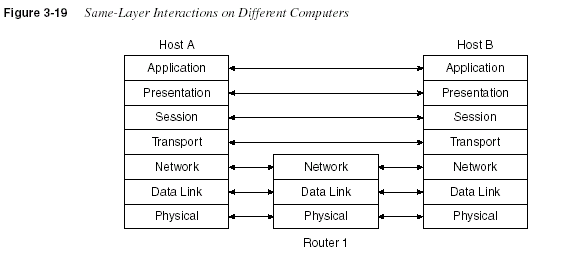
Table 3-14 summarizes the concepts behind error recovery and lists the behavior of three
popular error-recovery protocols.
Table 3-14
Examples of Error-Recovery Protocols and Their FeaturesFeature TCP SPX LLC2
Acknowledges data in both directions? Yes Yes Yes
Provides forward acknowledgment? Yes Yes Yes
Counts bytes or frame/packets? Bytes Packets Frames
Necessitates resending of all data, or
just one part and wait when resending?
One and wait Resend all Resend all
Foundation Summary
115Table 3-15 summarizes the flow control terms and provides examples of each of the three types
of flow control.
Table 3-16 summarizes most of the details about MAC addresses.
Table 3-15
Flow-Control Methods—SummaryName Used in This Book Other Names Example Protocols
Buffering — —
Congestion avoidance Stop/Start, RNR, Source Quench SDLC, LAPB, LLC2
Windowing — TCP, SPX, LLC2
Table 3-16
LAN MAC Address Terminology and FeaturesLAN Addressing Terms and
Features Description
MAC Media Access Control. 802.3 (Ethernet) and 802.5 (Token
Ring) are the MAC sublayers of these two LAN data link
protocols.
Ethernet address, NIC address, LAN
address, Token Ring address, card
address
Other names often used instead of MAC address. These
terms describe the 6-byte address of the LAN interface card.
Burned-in address The 6-byte address assigned by the vendor making the card.
It is usually burned in to a ROM or EEPROM on the LAN
card, and it begins with a 3-byte Organizationally Unique
Identifier (OUI) assigned by the IEEE.
Locally administered address Via configuration, an address that is used instead of the
burned-in address.
Unicast address Fancy term for a MAC that represents a single LAN
interface.
Broadcast address An address that means “all devices that reside on this LAN
right now.”
Multicast address Not valid on Token Ring. On Ethernet, a multicast address
implies some subset of all devices currently on the LAN.
Functional address Not valid on Ethernet. On Token Ring, these addresses are
reserved to represent the device(s) on the ring performing a
particular function. For example, all source-route bridges
supply the ring number to other devices. To do so, they each
listen for the Ring Parameter Server (RPS) functional
address.
116
Chapter 3: OSI Reference Model & Layered CommunicationTable 3-17 summarizes the different choices for encoding protocol types for each of the four
data link protocols covered in this chapter.
Table 3-18 summarizes the basic functions of data link protocols.
Table 3-17
Different Choices for Encoding Protocol Types for Each of the Four Data Link ProtocolsData Link Protocol Field
Header in Which It Is
Found Size
Ethernet and Token Ring DSAP 802.2 header 1 byte
Ethernet and Token Ring SSAP 802.2 header 1 byte
Ethernet and Token Ring Protocol Type SNAP header 2 bytes
Ethernet (DIX) Ethertype Ethernet header 2 bytes
HDLC Cisco proprietary
protocol id field
Extra Cisco header 2 bytes
Frame Relay RFC 1490 NLPID RFC1490 1 byte
Frame Relay RFC 1490 L2 or L3 Protocol ID Q.933 2 bytes each
Frame Relay RFC 1490 SNAP Protocol Type SNAP header 2 bytes
Table 3-18
Data Link Protocol FunctionsFunction Ethernet Token Ring HDLC Frame Relay
Arbitration CSMA/CD
algorithm (part of
MAC)
Token passing
(part of MAC)
— —
Addressing Source and
destination MAC
addresses
Source and
Destination MAC
addresses
Single 1-byte
address;
unimportant on
point-to-point links
DLCI used to
identify virtual
circuits
Error detection FCS in trailer FCS in trailer FCS in trailer FCS in trailer
Identifying
contents of
“data”
802.2 DSAP, SNAP
header, or
Ethertype, as
needed
802.2 DSAP, or
SNAP header, as
needed
Proprietary Type
field
RFC 1490
headers, with
NLPID, L2 and
L3 protocol IDs,
or SNAP header
Foundation Summary
117Table 3-19 outlines several Layer 3 address structures.
Figure 3-20 illustrates the construction of frames, packets, and segments and shows the
different layers’ perspectives on what is considered to be the data.
Table 3-19
Layer 3 Address StructuresProtocol
Size of
Address
(Bits)
Name and Size of
Grouping Field
Name and Size of Local
Address Field
IP 32 Network or subnet (variable,
between 8 and 30 bits)
Host (variable, between 2 and 24
bits)
IPX 80 Network (32) Node (48)
AppleTalk 24 Network (16) (Consecutively
numbered values in this field
can be combined into one
group, called a cable range.)
Node (8)
OSI Variable Many formats, many sizes DSP (typically 56, including NSAP)
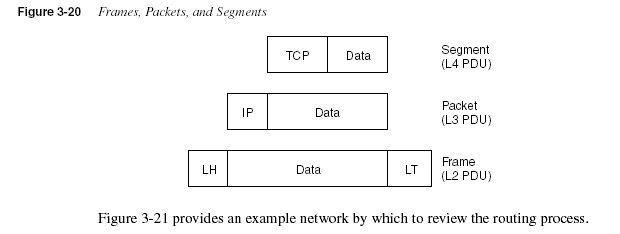

Q&A
As mentioned in Chapter 1, “All About the Cisco Certified Network Associate Certification,”
the questions and scenarios in this book are more difficult than what you should experience on
the actual exam. The questions do not attempt to cover more breadth or depth than the exam;
however, they are designed to make sure that you know the answer. Rather than allowing you
to derive the answer from clues hidden inside the question itself, the questions challenge your
understanding and recall of the subject. Questions from the “Do I Know This Already?” quiz
from the beginning of the chapter are repeated here to ensure that you have mastered the
chapter’s topic areas. Hopefully, these questions will help limit the number of exam questions
on which you narrow your choices to two options and then guess.
The answers to these questions can be found in Appendix A, on page 710.
1
Name the seven layers of the OSI model.2
What is the main purpose(s) of Layer 7?3
What is the main purpose(s) of Layer 6?4
What is the main purpose(s) of Layer 5?5
What is the main purpose(s) of Layer 4?6
What is the main purpose(s) of Layer 3?7
What is the main purpose(s) of Layer 2?8
What is the main purpose(s) of Layer 1?9
Describe the process of data encapsulation as data is processed from creation until it exitsa physical interface to a network. Use the OSI model as an example.
10
Describe the features required for a protocol to be considered connectionless.11
Name at least three connectionless protocols.12
Describe the features required for a protocol to be considered connection-oriented.13
In a particular error-recovering protocol, the sender sends three frames, labeled 2, 3, and4. On its next sent frame, the receiver of these frames sets an acknowledgment field to 4.
What does this typically imply?
14
Name three connection-oriented protocols.15
What does MAC stand for?16
Name three terms popularly used as a synonym for MAC address.17
Are IP addresses defined by a Layer 2 or Layer 3 protocol?18
Are IPX addresses defined by a Layer 2 or Layer 3 protocol?120
Chapter 3: OSI Reference Model & Layered Communication19
Are OSI NSAP addresses defined by a Layer 2 or Layer 3 protocol?20
What portion of a MAC address encodes an identifier representing the manufacturer of thecard?
21
Are MAC addresses defined by a Layer 2 or Layer 3 protocol?22
Are DLCI addresses defined by a Layer 2 or Layer 3 protocol?23
Name two differences between Layer 3 addresses and Layer 2 addresses.24
How many bits are present in an IP address?25
How many bits are present in an IPX address?26
How many bits are present in a MAC address?27
Name the two main parts of an IPX address. Which part identifies which “group” thisaddress is a member of?
28
Name the two main parts of an IP address. Which part identifies which “group” thisaddress is a member of?
29
Name the two main parts of a MAC address. Which part identifies which “group” thisaddress is a member of?
30
Name three benefits to layering networking protocol specifications.31
What header and/or trailer does a router discard as a side effect of routing?32
Describe the differences between a routed protocol and a routing protocol.33
Name at least three routed protocols.34
Name at least three routing protocols.35
How does an IP host know what router to send a packet to? In which cases does an IP hostchoose to send a packet to this router instead of directly to the destination host?
36
How does an IPX host know which router to send a packet to? In which case does an IPXhost choose to send a packet to this router instead of directly to the destination host?
37
Name three items in an entry in any routing table.38
What OSI layer typically encapsulates using both a header and a trailer?Scenario 3-1
121Scenarios
Scenario 3-1
Given the network in Figure 3-22 and the address table in Table 3-20, perform the tasks that
follow. This scenario uses an imaginary Layer 3 addressing structure as a method to review
concepts. When in doubt, concentrate on the concepts. Also, the imaginary Layer 3 used in this
example is here only to allow you to concentrate on the concepts instead of a particular
protocol; there is no need to memorize this scheme or expect questions like this on the exam.
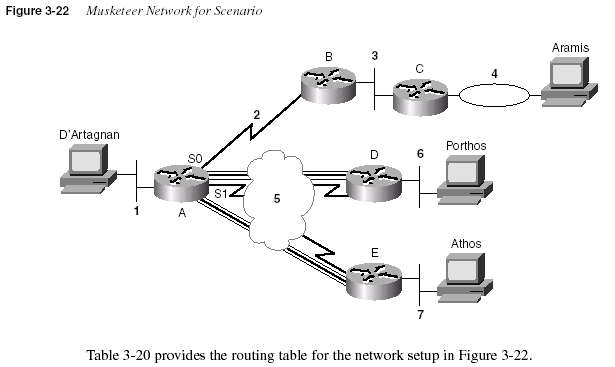
Table 3-20
Layer 3 Address Table for Network in Figure 3-22Router Interface Address
A E0 group-1.local-A
A S0 group-2.local-A
A S1 group-5.local-A
B S0 group-2.local-B
B E0 group-3.local-B
continues
122
Chapter 3: OSI Reference Model & Layered CommunicationTask 1 for Scenario 3-1
Create the routing table in Router A; assume that all parts of the network are up and working
properly. Table 3-21 provides an empty routing table to record your answers.
C E0 group-3.local-C
C T0 group-4.local-C
D S0 group-5.local-D
D E0 group-6.local-D
E S0 group-5.local-E
E E0 group-7.local-E
D’Artagnan group-1.local-M
Aramis group-4.local-M
Porthos group-6.local-M
Athos group-7.local-M
Table 3-21
Scenario 3-1 Task 1 Routing Table Answer FormGroup Outgoing Interface Next Router
Table 3-20
Layer 3 Address Table for Network in Figure 3-22 (Continued)Router Interface Address
Scenario 3-1
123Task 2 for Scenario 3-1
D’Artagnan sends a packet to Aramis (source group-1.local-M, destination group-4.local-M).
D’Artagnan sends this packet inside an Ethernet frame to Router A. Given this information,
determine the following:
1
List the routing table entries in each router that are necessary for the packet to be deliveredto Aramis.
2
What type of data link header or trailer is discarded by each router in that route?3
What destination data link addresses are placed into the new data link headers by eachrouter?
4
What routes must be in which routers to ensure that Aramis can send a return packet toD’Artagnan?
Task 3 for Scenario 3-1
D’Artagnan sends a packet to Porthos (source group-1.local-M, destination group-6.local-M).
D’Artagnan sends this packet inside an Ethernet frame to Router A. Given this information,
determine the following:
1
List the routing table entries in each router that are necessary for the packet to be deliveredto Porthos.
2
What type of data link header or trailer is discarded by each router in that route?3
What destination data link addresses are placed into the new data link headers by eachrouter?
4
What routes must be in which routers to ensure that Porthos can send a return packet toD’Artagnan?
124
Chapter 3: OSI Reference Model & Layered CommunicationScenario Answers
Answers to Task 1 for Scenario 3-1
Based on the network design illustrated in Figure 3-22, Task 1 for Scenario 3-1 asks you to
create the routing table in Router A; assume that all parts of the network are up and working
properly. The routing table for Router A is as follows:
Answers to Task 2 for Scenario 3-1
Based on the network design illustrated in Figure 3-22, Task 2 for Scenario 3-1 states that
D’Artagnan sends a packet to Aramis (source group-1.local-M, destination group-4.local-M).
D’Artagnan sends this packet inside an Ethernet frame to Router A. The following are the
solutions to exercises 1 through 4 for Task 2.
1
The routing tables are as follows:In Router A:
In Router B:
Group Outgoing Interface Next Router
group-1 Ethernet 0 —
group-2 serial 0 —
group-3 serial 0 group-2.local-B
group-4 serial 0 group-2.local-B
group-5 serial 1 —
group-6 serial 1 group-5.local-D
group-7 serial 1 group-5.local-E
Group Outgoing Interface Next Router
group-2 serial 0 —
group-4 serial 0 group-2.local-B
Group Outgoing Interface Next Router
group-3 Ethernet 0 —
group-4 Ethernet 0 group-3.local-C
Answers to Task 2 for Scenario 3-1
125In Router C:
2
Router A discards the Ethernet header and adds an HDLC header. Router B discards theHDLC header and adds an Ethernet header. Router C discards the Ethernet header and
adds a Token Ring header.
3
Router A places the never-changing HDLC address (Hex 03) into the header. Router Bplaces Router C’s Ethernet MAC address into the destination address field. Router C
places Aramis’s Token Ring MAC address into the destination address field.
4
This is all noise if Aramis cannot get a packet back to D’Artagnan. The following routingtables show the routes needed for both directions; the routes with asterisks signify routes
required for the routes back to D’Artagnan.
In Router A:
In Router B:
In Router C:
Group Outgoing Interface Next Router
group-4 Token Ring 0 —
Group Outgoing Interface Next Router
group-1* Ethernet 0 —
group-2 serial 0 —
group-4 serial 0 group-2.local-B
Group Outgoing Interface Next Router
group-1* serial 0 group-2.local-A
group-2* serial 0 —
group-3 Ethernet 0 —
group-4 Ethernet 0 group-3.local-C
Group Outgoing Interface Next Router
group-1* Ethernet 0 group-3.local-B
group-3* Ethernet 0 —
group-4 Token ring 0 —
126
Chapter 3: OSI Reference Model & Layered CommunicationAnswers to Task 3 for Scenario 3-1
Based on the network design illustrated in Figure 3-22, Task 3 for Scenario 3-1 states that
D’Artagnan sends a packet to Porthos (source group-1.local-M, destination group-6.local-M).
D’Artagnan sends this packet inside an Ethernet frame to Router A. The following are the
solutions to exercises 1 through 4 for Task 3.
1
The routing tables are as follows:In Router A:
In Router D:
2
Router A discards the Ethernet header and adds a Frame Relay header. Router D discardsthe Frame Relay header and adds an Ethernet header.
3
Router A places the Frame Relay DLCI for the VC connecting it to Router D into theaddress field in the header. Router D places Porthos’s Ethernet MAC address into the
destination address field.
4
This is all noise if Porthos cannot get a packet back to D’Artagnan. The following routingtables show the routes needed for both directions; the routes with asterisks signify routes
required for the routes back to D’Artagnan.
In Router A:
Group Outgoing Interface Next Router
group-5 serial 1 —
group-6 serial 1 group-5.local-D
Group Outgoing Interface Next Router
group-6 Ethernet 0 —
Group Outgoing Interface Next Router
group-1* Ethernet 0 —
group-5 serial 1 —
group-6 serial 1 group-5.local-D
Answers to Task 3 for Scenario 3-1
127In Router D:
Group Outgoing Interface Next Router
group-1* serial 0 group-5.local-A
group-5* serial 0 —
group-6 Ethernet 0 —